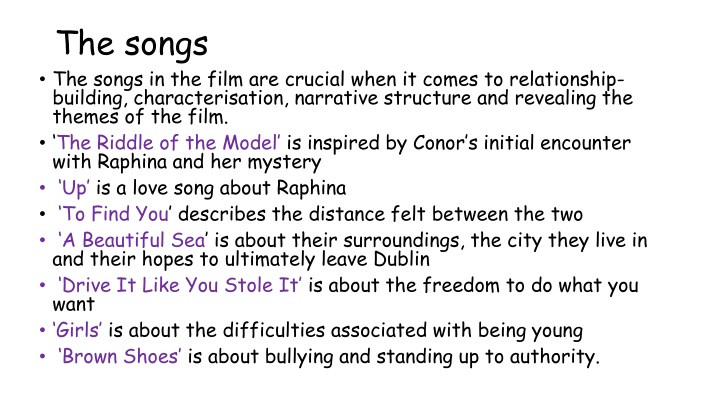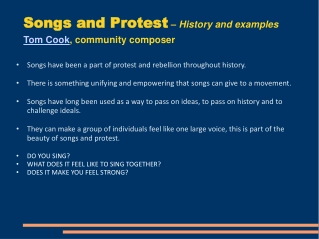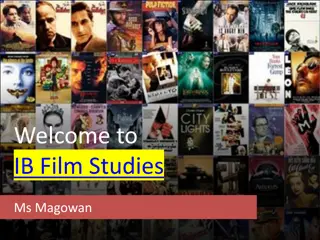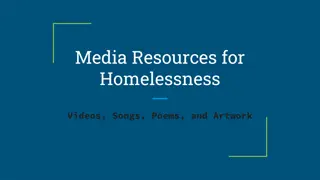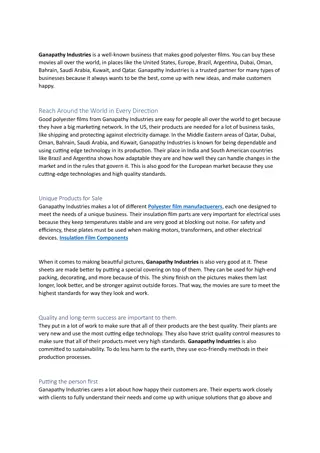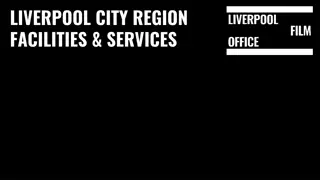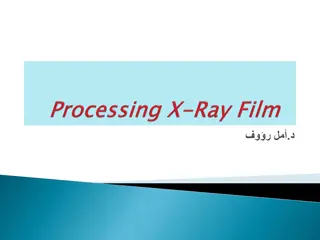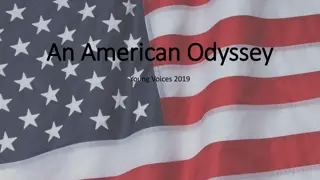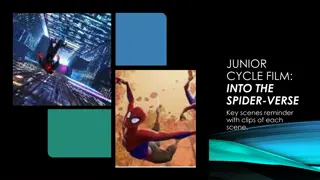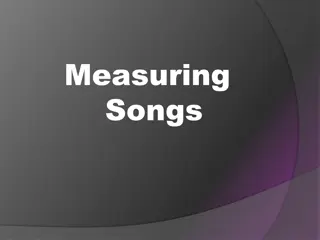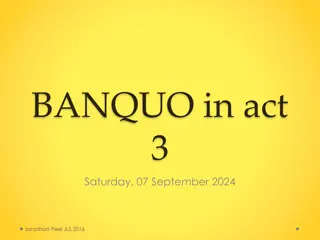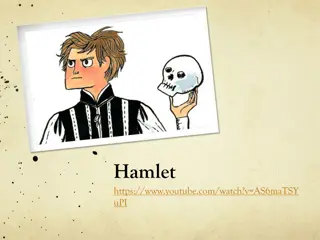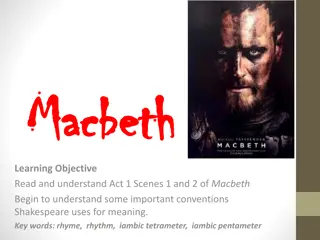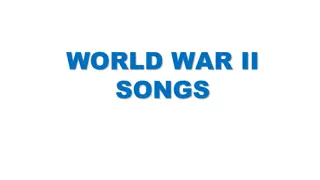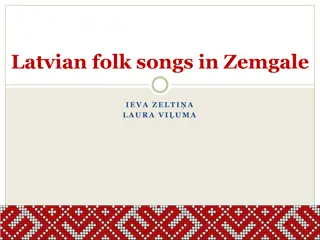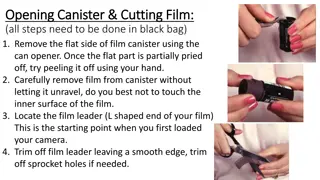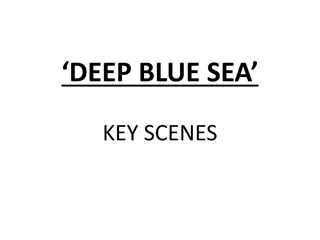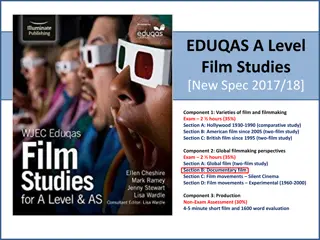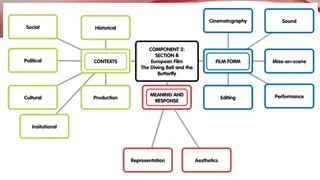The Impact of Songs and Key Scenes in a Film Analysis
The songs in the film play a crucial role in relationship-building, character development, narrative structure, and theme exploration. A close analysis of a key scene involving a prom video rehearsal reveals the imaginative aspects of the protagonist's desires and ambitions, highlighting themes of fantasy, love, and self-confidence through music, visuals, and camera angles.
Download Presentation

Please find below an Image/Link to download the presentation.
The content on the website is provided AS IS for your information and personal use only. It may not be sold, licensed, or shared on other websites without obtaining consent from the author.If you encounter any issues during the download, it is possible that the publisher has removed the file from their server.
You are allowed to download the files provided on this website for personal or commercial use, subject to the condition that they are used lawfully. All files are the property of their respective owners.
The content on the website is provided AS IS for your information and personal use only. It may not be sold, licensed, or shared on other websites without obtaining consent from the author.
E N D
Presentation Transcript
The songs The songs in the film are crucial when it comes to relationship- building, characterisation, narrative structure and revealing the themes of the film. The Riddle of the Model is inspired by Conor s initial encounter with Raphina and her mystery Up is a love song about Raphina To Find You describes the distance felt between the two A Beautiful Sea is about their surroundings, the city they live in and their hopes to ultimately leave Dublin Drive It Like You Stole It is about the freedom to do what you want Girls is about the difficulties associated with being young Brown Shoes is about bullying and standing up to authority.
Close analysis of a key scene: prom video rehearsal This sequence appears to be imagined by Conor as it is immediately followed by the actual events and we see him snap out of this dream sequence. It s a fantasy set-piece in which Conor s life briefly is how he desires it Raphina shows up as his prom date; the school principal s behaviour completely reverses from strict to fun- loving; his parents are happily married and interested in their son; and his older brother becomes a hero to all by protecting Raphina from her unwanted former boyfriend. Even the clothes, set design and Conor s confidence changes. https://www.youtube.com/watch?v=OYxyhXHiae0
Close analysis of a key scene: prom video rehearsal Shot switches from Conor explaining the premise of the video to the group of students in the audience. A medium shot is used (camera angle). Worm s eye shot (camera angle) to show the audience looking up to Conor he feels confident performing Bird s eye view (camera angle) to show Conor looking down at the audience while Conor cannot ensure Raphina is present at the video, he can control the audience. The use of sound (music and sound) before the music starts shows the low level of enthusiasm and unprofessionalism of the video shoot. We hear the lacklustre clicking of fingers and the awkward shuffling sounds of the audience dancing. The opening chords of the song Drive it like you stole it (music and sound) begins and we see a close up shot of the hall door. Conor is hoping Raphina may arrive. An extreme close up (camera angle) of Conor s face reveals to us that he is upset. The camera switches back and forth between Conor s face and the door (camera angle) . Close up of Raphina entering (camera angle) There is a soft spotlight (lighting) on her which gives the scene a dreamlike quality. Her hair and make up reveal to us that this is a fantasy scene as she is dressed in clothing popular in the 1950 s (costume).
Close analysis of a key scene: prom video rehearsal Close up shot (camera angle) of Raphina s face. Her face is tilted looking up at the stage where Conor is singing. A slow smile crosses her face. In the background we can see that the hall is full of students dancing in 1950 s clothing. Tracking/dolly shot (camera angle) slowly circling Raphina until we see her view of Conor on stage. He is in an extravagant 1950 s style costume (costume). Camera switches between Conor and Raphina (bird s eye view to worm s eye view) (camera angle) so that the audience can see the two maintaining eye contact. Conor seems confident and happy, while Raphina looks to be in awe of him. Colours present in the scene are largely red and blue. Red symbolises the love he has for Raphina and the blue could be seen to symbolise the calming effect music has had on Conor s turbulent life style. Alternatively you can focus on the use of the three colours associted with the American flag red, white and blue. These colours symbolise freedom.
Close analysis of a key scene: prom video rehearsal Tracking/dolly shot (camera angle) of Brother Baxter doing a back flip into the hall. This confirms the scene is a dream sequence. Tracking/dolly shot (camera angle) of Conor s parents arriving to the dance and happily saluting Conor. They seem to be happy in their marriage and proud of their son on stage. Conor s father is wearing a white suit symbolising the peace that Conor desires in his family. His mother is wearing a green dress perhaps hinting at his desire for his mother to nurture and look after him (costume). Brendan arrives on a motorcycle with a loud roar from the engine. There is a smoky light (lighting) behind him to dramatize his entrance. The fight scene features a mix of close up shots and tracking/dolly shots (camera angle) to add emphasise to the danger and drama of the scene. The choreographed dancing of the audience where each person is dancing in unison symbolises Conor s desire for unity in his life. He wants his family to be amicable with one another and he wants his school life to improve. The song Drive it like you stole it symbolises Conor s desire for freedom (music and sound). He wants to rebel against the strict rules on his life. He wants to be with Raphina and have a happy home life. He wants Brother Baxter to stop bullying him. He wants the freedom to perform his music the way he wants to.
Close analysis of the opening scene Immediately Sing Street establishes the importance of music not only to the story but to the main character. At this stage in the story however, Conor s music is more of a private passion. The film introduces him alone in his room. This creates the impression that Conor Lawlor is somewhat of a reserved person. He s not particularly sociable. This creates a special bond between the audience and the protagonist. It also sets up expectations for a character arc where he comes out of his shell. This first impression of Conor Lawlor is confirmed when the film introduces the rest of his family. In comparison his brother and father are loud and eccentric. This is why introducing Conor in the quiet, creative, private space of his room is so important.
Close analysis of the opening scene The scene opens with Conor playing his guitar in his bedroom. We see an extreme close up of his guitar (camera angle) His parents fighting in the background can be heard (music and sound). Conor angrily slams his bedroom door shut. This reveals to the audience that Conor comes from an unhappy home where dysfunction is at the core. The camera moves from a medium shot to a close up of Conor s face (camera angle). Conor sings I m the mechanic to your heart, and with a wrench I ll take you apart. (music and sound) Realistic high key lighting is used in this scene (lighting) Conor sings if we didn t share a mortgage I would leave you. (music and sound) He sings what he hears his parents shouting at each other. This shows that he is heavily influenced by his home situation. It also reveals to us that Conor s family is in financial difficulty. This is further emphasised by the fact that Conor is wearing a hat and scarf inside, perhaps they cannot afford to pay for their heating (costume). Conor s father is heard shouting well leave anytime you d like...you stupid bitch (music and sound). Conor mimics this in a deep, low voice. The scene immediately cuts to a clip showing the news . The news reporter discusses the economic situation in Ireland in the 1980 s. This reveals the context of the film. The opening scene can be extending to analysis of the family discussion at the kitchen table where the Lawlor s financial situation is further explained.
Close analysis of a scene: The ending https://www.youtube.com/watch?v=fwo4BcmG7w8 Sing Street ends with the film s hero, teenage Conor steering a boat across the English channel with the love of his life, Raphina. Adam Levine s original song Go Now plays as waves crest and rain splashes, making the entire sequence feel like a music video. For Carney, playing with reality and audience expectations was intentional, The idea of the scene is whether this is in his head now or if it s happening. I didn t want to answer that. Whether or not Conor and Raphina are truly experiencing their waterlogged final trip across the channel is left up to viewers. When you are caught up in your own drama, there is a sort of magical realism particularly when you re young about what s happening, Carney said. You fill in the visuals in your head, slightly. I wanted to capture that, but I didn t want to qualify anything at the end or tell the audience how they should think or feel. We wanted to create something that...sounded like it could even be the brother s lyrics or it could even be a projection of how these guys could sound in the future, like the 90s, Carney said. There s a sense of heartbreak and sadness, there s a sense of hopefulness about it as well. It s not a pop song, it s a ballad.
Close analysis of a scene: The ending low key lighting (lighting) is used to convey the uncertainty of the scene. Conor and Raphina have made the decision to sail to England which brings uncertainty and change into their future. In the car we see extreme close ups (camera angle) of Brendan, Conor and Raphina. All three are smiling and laughing. They are elated to be taking control of the situation and breaking out of their oppressive home lives. Brendan and Conor s conversation by the boat uses a point-of- view shot (camera angle). We see Brendan from Conor s point of view. Brendan is standing on the step above Conor to show that Conor looks up to his older brother.
Close analysis of a scene: The ending The lighting gradually gets brighter as the scene continues (lighting). This shows the sense of relief Conor feels at escaping his life in Ireland. He feels lighter and brighter about taking control of his situation. The symbolism of the sea water has redemptive symbolism is film and fiction. Water symbolises new beginnings and hope. The overall colour is blue sense of calm and perhaps even a hint of sorrow at the new beginning that awaits Conor and Raphina. The boat is white which symbolises the couple s innocence in their attempt to journey to London by a small boat. Long shot (camera angle) of Conor and Raphina sailing away. We see a point-of- view shot (camera angle) as Brendan watches his brother leave Ireland. Extreme close up (camera angle) of Conor looking back towards the Irish shore. The lyrics of Adam Levine s song just face ahead no going back now can be heard as Conor turns to face the direction of England and his new life (music and sound). Point-of-view shot (camera angle) we see how choppy the sea is as we look at the nose of the boat being buffeted by the waves. This symbolises that the couple s new life will not be easy and they will face many challenges ahead.
Close analysis of a scene: The ending Low key lighting (lighting) is used when the storm hits. We hear the pounding of waves and the crash of the sea (music and sound) The large ship taking the paying passengers to England crosses their path, nearly crashing in to them. This shows that the couple are taking the hard way to achieve their goals. They see how easy it could be but unfortunately they do not have the luxury of taking the easy route. Final shot is a close up of Conor s face (camera angle). The rain and waves are hitting him in the face yet there is a look of determination and happiness evident in his facial expression. Despite the difficulties that lie ahead, the film ends on a positive note. Adam Levine s song Go Now is the soundtrack to the scene (music and sound). The lyrics have specific relevance to Conor and Raphina choosing to control their destiny and moving to London e.g. So here we are,we've got another chance for life ; You've come so far, now see, you're cutting all the ties, you're right, go on ; We're never gonna go if we don't go now In this scene Raphina is wearing clothing and make up that is reminiscent of the first scene we see her in (costume). She feels confident again, like she did at the start of the film when she tells Conor she is a model. Taking control of her life and moving for better prospects makes Raphina feel good about herself and this is reflected in her clothing.
Go Now Adam Levine So, here we are We've got another chance for life It's what you want I can see it in your eyes You see so clear It's coming into light Go on be wrong Cause tomorrow you'll be right Don't sit around and talk it over You're running outta time Just face ahead No going back now You've come so far Now see, you're cutting all the ties You're right, go on Keep running for your life Made up your mind, no going back now See it all come falling down You've tried so hard to figure out Just what it's all about You're fighting on and on and on For what you know it's true Now say, "go on and on and on Do all that you can do" Hey, we're never gonna go if we don't go now You're never gonna know if you don't find out You're never going back, never turning around You're never gonna go if don't go now You're never gonna grow if you don't grow now You're never gonna know if you don't find out You're never going back, never turning around You're never gonna go if you don't go now You're never gonna go if you don't go now You're never gonna know if you don't find out You're never turning back, never turning around You're never gonna go if you don't go
